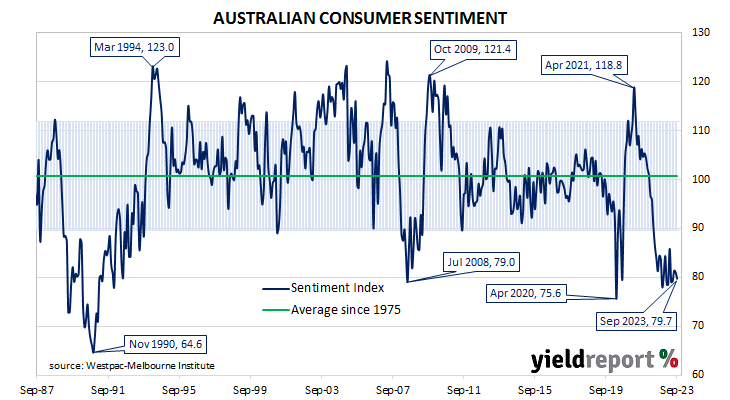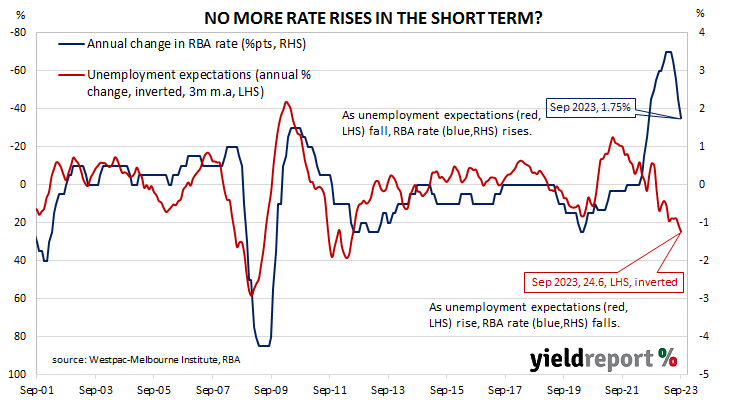Summary: Household sentiment declines again; mortgage holders’ confidence up, outright home owners’ and renters’ confidence down; NAB: total consumer spending quite high, many businesses enjoying relatively high levels of activity; three of five sub-indices lower; more respondents expecting higher jobless rate.
After a lengthy divergence between measures of consumer sentiment and business confidence in Australia which began in 2014, confidence readings of the two sectors converged again in mid-July 2018. Both measures then deteriorated gradually in trend terms, with consumer confidence leading the way. Household sentiment fell off a cliff in April 2020 but, after a few months of to-ing and fro-ing, it then staged a full recovery. However, consumer sentiment has deteriorated significantly over the past two years, while business sentiment has been more robust.
According to the latest Westpac-Melbourne Institute survey conducted in the first week of September, household sentiment has declined again. Their Consumer Sentiment Index fell from August’s reading of 81.0 to 79.7, a reading which is well below the “normal” range and significantly lower than the long-term average reading of just over 101.
“Persistent pessimism has continued despite easing fears of further interest rate rises,” said Westpac Chief Economist Bill Evans. “This has seen a clear lift in the confidence of mortgage holders, up 7.8% in the latest month. However, this gain was more than offset by a 6.1% fall in the confidence of renters and a 5.8% fall in the confidence of consumers that own their home outright.”
Any reading of the Consumer Sentiment Index below 100 indicates the number of consumers who are pessimistic is greater than the number of consumers who are optimistic.
The report was released on the same day as the latest NAB Business Survey and Commonwealth Government bond yields moved slightly higher on the day. By the close of business, 3-year and 10-year ACGB yields had both inched up 1bp to 3.84% and 4.17% respectively while the 20-year yield finished 2bps higher at 4.51%.
In the cash futures market, expectations regarding further rate rises barely moved. At the end of the day, contracts implied the cash rate would change little from the current rate of 4.07% and average 4.08% through October, 4.13% in November and 4.15% in December. February 2024 contracts implied a 4.165% average cash rate and May 2024 contracts implied 4.145%, 7.5bps more than the current rate.
Ray Attrill, NAB’s Head of FX Strategy (Markets), discussed the difference between weak consumer sentiment and robust business conditions. “In trying to reconcile the contrast, we might note that while consumer spending growth has slowed, in line with the ongoing hits to real incomes, such that there is a per capital recession, the level of consumer spending remains quite high. One way to reconcile this might be to note that inward migration is running very strong, such that many businesses are still enjoying relatively high levels of activity.”
Three of the five sub-indices registered lower readings, with the “Family finances versus a year ago” sub-index posting the largest monthly percentage loss.
The Unemployment Expectations index, formerly a useful guide to RBA rate changes, increased from 127.2 to 130.8. Higher readings result from more respondents expecting a higher unemployment rate in the year ahead.



